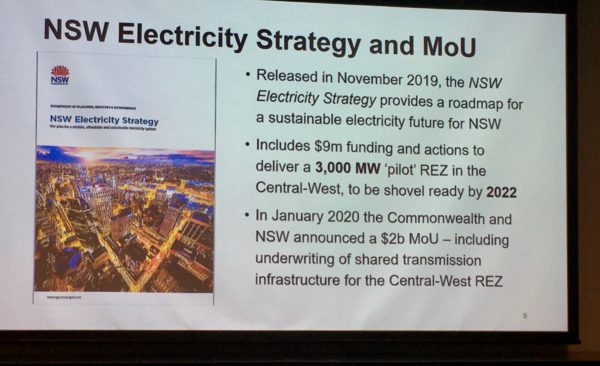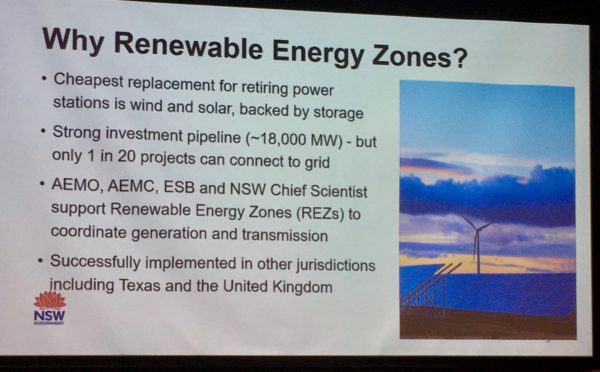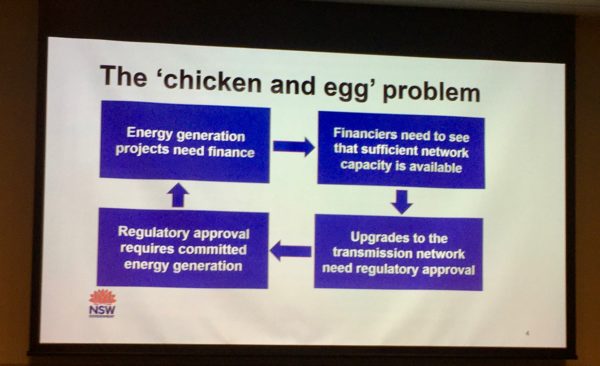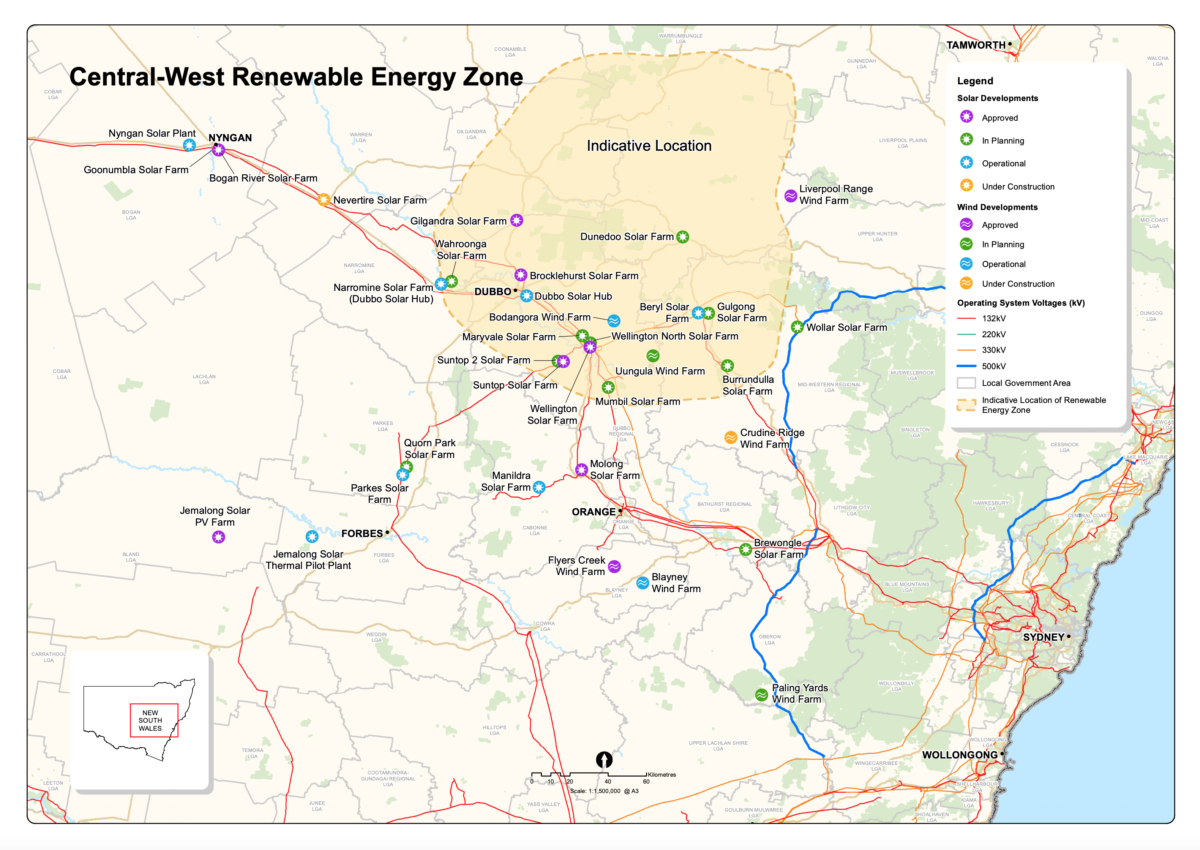A Memorandum of Understanding signed with the Commonwealth Government in January has helped to accelerate New South Wales planning and development of Australia’s first Renewable Energy Zone in the Central West of the state, in the area of rich renewable resource surrounding the city of Dubbo.
At the Informa Large Scale Solar Conference last week, Rohan Tayler, Principal Policy Officer for Energy Infrastructure in the NSW Department of Planning and Environment, said the MoU for $2 billion of joint state and Commonwealth funding of emissions-reductions initiatives “includes underwriting for the shared network we need for a renewable energy zone”.
The investment adds to $9 million of already committed state government funds, contributing to the NSW Government’s build-it-and-they-will come approach to transmission; instead of following to a RIT-T the process of showing generation ready to connect, which would then justify new network infrastructure build.
“You can’t get renewable energy zones under the current framework,” said Tayler, referring to the Regulatory Investment Test for Transmission, which was designed in an era when the need for substantial new network build was not anticipated, and which grinds unreasonably slowly to decisions given the urgency of energy transition in Australia.
Although Renewable Energy Zones (REZs) have been included in the Integrated System Plan (ISP) — the Australian Energy Market Operator’s transition vision — since its first version in 2018, Taylor told pv magazine at the conference that they were at that time identified as a Group 3 priority, meaning it was anticipated REZs would not be required until the 2030s.
For NSW, he said, the scheduled retirement of coal-fired power stations — beginning with Liddell in 2023 and the Yallourn and Vales Point B generators in 2030 — means new firmed renewable generation will have to be brought to market much earlier.
In mid 2019, Green Energy Markets Director, Tristan Edis estimated that NSW will need “close to an additional 5,000 MW of new renewable energy project commitments by 2030”, to close the gap left by coal-plant retirements.

The pipeline of renewables is not the problem
Tayler estimates the current NSW investment pipeline at some 18,000 MW of renewable-energy projects that either have planning approval or are seeking planning approval, “but critically do not have a connection to the grid”, he said at last week’s conference.
“That is the crux of where we’re at; the grid is rapidly running out of space, and really only one in 20 of those projects are likely to get up, which is really demoralising.”
Renewable Energy Zones were conceived of as a way to plan concentrations of renewable generation alongside firming mechanisms such as storage in areas of high renewable resource, and co-ordinated with strong transmission that could deliver electricity to areas of high demand.
The Central West REZ was tagged for pilot status in the NSW Electricity Strategy which was released in November last year.

Now Tayler and his team coordinating five key interrelated work streams, to bring the project to stage where he can invite expressions of interest from developers and initiate an auction process for delivery of 3,000 (or so) megawatts of energy.
He says, recognising “the complimentarity of energy sources … when you combine wind and solar it may be higher than 3,000 MW”.
Tayler also recognises that in the absence of a state Renewable Energy Target that would deliver certainty and benefits to investors, the REZ will have to provide real value. NSW plans to offer that in the form of assured physical access — the grail of connection — to the grid.
“By targeting physical access we can provide a level of insurance against things like congestion, MLF and free-rider risks, though there may also be a financial component on the other side if we can’t control physical access — to compensate financially for any losses,” said Tayler.
Victoria’s RIT-T rebellion spreads
He added that NSW would aim to provide access to the network via the framework of the National Electricity Rules, or through the Council of Australian Governments, but said “if we need to, we might follow the Victorian approach and look to derogate from the rules”.
This last option puts NSW on a similar path of circumventing the bygone-era pace of the RIT-T process to that taken by the state Government of Victoria.
After five solar farms were curtailed in September, and a further 45 renewable generators were placed in a queue for connection to the grid due to system strength issues in the West Murray region of Victoria early this year, the Victorian Government introduced legislation into Parliament that will enable it to chart its own path on key parts of current national transmission planning and development.
According to Energy Networks Australia, the proposed laws, set to be debated in Parliament on Wednesday this week, “give the Victorian Minister wide-ranging powers to bypass some of the requirements in the national energy regulatory framework”.

Image: NSW Department of Planning & Environment
Setting an example for co-ordinated delivery of renewables
With this pilot REZ, the NSW Government is staking its reputation with the community as a state committed to renewable-energy deployment, carbon-emissions reduction and widely distributed stakeholder benefits.
“We recognise that the Government’s credibility is on the line here, and we really want this REZ to prove up going ahead and doing more of these things,” said Tayler.
Consultations with community and industry will therefore be held this coming quarter (Q2 of 2020) in advance of the Development Approval process for the Central West REZ, to gain an understanding of community concerns and competing interests, and to identify how regional interests can be met by the development process.
A statutory entity, known as the REZ Body, will support generator development approvals. “It may have a role in seeking approvals for contestable parts of the network and then onselling those approvals to investors,” explains Tayler. It will also use its land-acquisition powers to help facilitate grid connection.
He says his team is working to create a model that fairly and equitably shares the costs of shared infrastructure, such as potential energy storage and network augmentation.
In short, NSW aims to show how coordination and planning can lead to better outcomes for all stakeholders, while more rapidly rolling out reliable electricity generation for the state, and for the National Energy Market as a whole.
Tayler says NSW is working to reform the regulatory process for urgently required transmission build, but “We’re not going to wait around for those reforms to happen … From Q2 you’ll be starting to hear a lot more from us.”
This content is protected by copyright and may not be reused. If you want to cooperate with us and would like to reuse some of our content, please contact: editors@pv-magazine.com.









1 comment
By submitting this form you agree to pv magazine using your data for the purposes of publishing your comment.
Your personal data will only be disclosed or otherwise transmitted to third parties for the purposes of spam filtering or if this is necessary for technical maintenance of the website. Any other transfer to third parties will not take place unless this is justified on the basis of applicable data protection regulations or if pv magazine is legally obliged to do so.
You may revoke this consent at any time with effect for the future, in which case your personal data will be deleted immediately. Otherwise, your data will be deleted if pv magazine has processed your request or the purpose of data storage is fulfilled.
Further information on data privacy can be found in our Data Protection Policy.